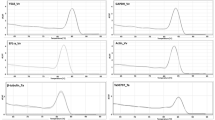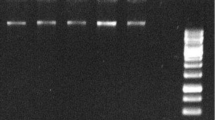Abstract
Difficulties extracting high-quality RNA from recalcitrant plant tissues are often due to high levels of phenolics, carbohydrates, or other compounds that bind and/or co-precipitate with RNA. We describe here a method using soluble polyvinylpyrrolidone (PVP) and ethanol precipitation, which has been successful in several recalcitrant systems where other specialized RNA extraction methods failed to deliver suitable product. Using this method, RNA capable of reverse-transcription/PCR amplification and cDNA library construction was isolated from ripening grape berries, dry seeds of Albizia procera and radish, and leaf tissue of A. procera and Griffonia simplicifolia. This method is applicable to a variety of plant tissues.
Similar content being viewed by others
References
Chang S, Puryear J and Cairney J (1993) A simple and efficient method for isolating RNA from pine trees. Plant Mol Biol Reptr 11: 113–116.
Chomczynski P and Sacchi N (1987) Single-step method of RNA isolation by acid guani-dinium thiocyanate-phenol-chloroform extraction. Anal Biochem 162: 156–159.
Lewinsohn E, Steele C and Croteau R (1994) Simple isolation of functional RNA from woody stems of gymnosperms. Plant Mol Biol Reptr 12: 20–25.
Loomis WD (1974) Overcoming problems of phenolics and quinones in the isolation of plant enzymes and organelles. Meth Enzymol 31: 528–545.
Terras FRG, Eggermont K, Kovaleva V, Raikhel NV, Osborn RW, Kester A, Rees SB, Tor-rekens S, VanLeuven F, Vanderleyden J, Cammue BPA and Broekaert WF (1995) Small cysteine-rich antifungal proteins from radish: their role in host defense. Plant Cell 7: 573–588.
Tesniere C and Vayda ME (1991) Method for the isolation of high-quality RNA from grape berry tissues without contaminating tannins or carbohydrates. Plant Mol Biol Reptr 9: 242–251.
VanDriessche ES, Beeckmans R, Dejaegere R and Kanarek L (1984) Thiourea: The antioxi-dant of choice for the purification of proteins from phenol-rich tissues. Anal Biochem 141: 184–188.
Woodhead M, Taylor MA, Davies HV, Brennan RM and McNicol RJ (1997) Isolation of RNA from blackcurrant (Ribes nigrum L.) fruit. Mol Biotechnol 7(1): 1–4.
Author information
Authors and Affiliations
Rights and permissions
About this article
Cite this article
Salzman, R., Fujita, T., Zhu-Salzman, K. et al. An Improved RNA Isolation Method for Plant Tissues Containing High Levels of Phenolic Compounds or Carbohydrates. Plant Molecular Biology Reporter 17, 11–17 (1999). https://doi.org/10.1023/A:1007520314478
Issue Date:
DOI: https://doi.org/10.1023/A:1007520314478




